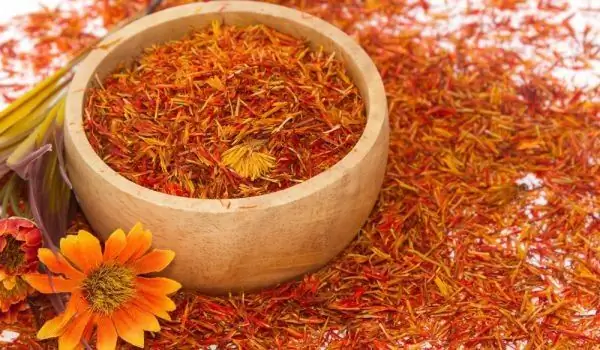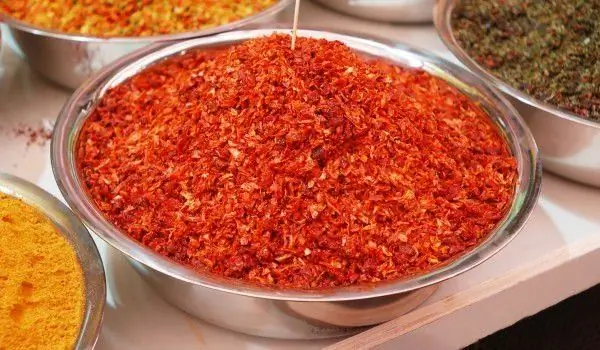2025 Author: Jasmine Walkman | [email protected]. Last modified: 2025-01-23 10:18
Saffron is considered to be one of the oldest spices used, having been popular for 3,000 years. Known as the "king of spices" today saffron is one of the most expensive, valuable and flavorful spices in the world. It gives dishes a unique taste and many of us are often willing to pay more to deliver a superb gastronomic experience.
By its nature saffron is a spice, which is obtained from the flowers of saffron crocus (Crocus sativus) - a cultivated species of crocus from the family Iris (Iridaceae). Saffron is characterized by its characteristic bitter taste and smell of iodoform or hay.
They are due to the chemicals picrocrocin and saffron. Saffron also contains the carotenoid dye crocin, which gives a rich golden-yellow color to food. Because of these qualities, saffron is a much sought after ingredient in many foods around the world.
It is also used in medicine, and in cooking it should be used in minimal quantities due to its strong taste and aroma. The name "saffron" comes from the Arabic word "za'faraan", which means "yellow". The Latin name of saffron is "safranum". 'Safranum' is also associated with the Italian 'zafferano' and the Spanish 'azafrán'.
History of saffron
Saffron is cultivated for the first time in the region of Greece. In the Middle East, saffron has long been known, with Egyptian medical texts mentioning 1500 BC. Even more ancient traces of saffron have been found in the ancient written sources of Sumerian civilization. The Minoans painted saffron in palace frescoes around 1500-1600 BC, presenting its use as a medicine. Even the legendary Cleopatra used saffron for her baths to give more pleasure when making love.
Egyptian healers have used saffron to treat all kinds of gastrointestinal complaints. Saffron is used and for dyeing fabrics in Levantine cities such as Sidon and Tire. The Roman scientist Avel Cornelius Celsus prescribed saffron in medicines for wounds, coughs, colic and scabies. The Romans were passionate fans of saffron. Colonizers brought saffron when they settled in southern Gaul, where it was widely cultivated until the fall of Rome in 271. Rival theories state that saffron did not return to France until the 8th century with the Moors or the papacy in Avignon in the 14th century.
Interesting legends are told around saffron. His name comes from ancient times and is associated with the name of a wonderful young man named Crocus. According to legend, there are two versions of the appearance of the plant. One tells how the god Hermes fell in love with a young man who killed by a stupid accident. At the place where his blood was shed, the beautiful crocus plant grew. According to the other version, Crocus was in love with a nymph with whom they were inseparable. Hermes turned the nymph into a bush and the young man into a beautiful plant, which they later called saffron.

Saffron composition
Saffron contains carotenoids, which are natural pigments derived from fruits and vegetables, as well as calcium salts, vitamins B1 and B2, wax and essential oil. The charming spice saffron contains over 150 essential and aromatic compounds, but it is also rich in many non-essential active ingredients.
Most of them are carotenoids, including zeaxanthin, lycopene and various α- and β-carotenes. The taste of saffron is due to the bitter glucoside picrocrocin, which makes up 4% of dry saffron. Zeaxanthin is one of the carotenoids in the spice, which is reddish in color and naturally present in the retina of the human eye.
Saffron is an essential oil, which is largely due to its specific odor. Saffron is characterized as less bitter than picrocrocin and can make up to 70% of the essential fraction of dry saffron.
Selection and storage of saffron
Apart from being one of the most ancient, saffron is also one of the most expensive spices. To obtain 1 kg of finished product, it is necessary to process about a thousand colors - a fact that determines its expensive price. Its price per kilogram reaches 6000 dollars.
Choose fiber carp only from controlled brands. Buy only carp, which is gentle and soft to the touch, with long fibers and a nice saturated color / red, sometimes yellow /. Saffron should be very fragrant, with a pleasant taste.
Store saffron in an airtight, opaque box. Keep it in a dark and dry place.

Culinary use of saffron
The strong peculiar saffron aroma and its ability to color dishes ensures its widespread use as a spice. It is used in confectionery in the preparation of biscuits, cakes, puddings, pastries, cakes. It is added to fruit jellies, creams, mousses and ice cream.
It is used to color light broths (vegetable, fish), vegetarian soups. In the Middle East and Southern Europe it is used for flavoring and coloring rice dishes (pilaf, paella, etc.). It is also added to dishes with lamb, fish and poultry to increase the aroma and color. It goes very well with tomatoes and asparagus.
As saffron is a strong spice, should be used in minimal amounts. An overdose can make dishes bitter. It is good to dissolve the saffron in a little hot broth, water or milk beforehand. The aqueous solution is obtained by adding 1 gram of spice to 120 g of hot water. The solution can be used after a minimum of 20 minutes.
In hot dishes, saffron is added 5 minutes before the end of cooking, and in the dough - when kneading.
Benefits of saffron
Saffron is so valuable for cooking, as well as for medicine, because from a medical point of view this spice has been used since time immemorial in traditional medicine and healing. Even today, modern medicine confirms the anti-cancer, antimutagenic, immunomodulatory and antioxidant properties of saffron.
It has been proven that taking 1 lollipop of saffron with each meal helps with hysteria, hemorrhoids. Saffron also helps with depression. It relieves depression because it helps make the happiness hormone serotonin.
The paste made from saffron has an anti-inflammatory effect. It helps with abrasions, insect bites and various skin inflammations. Thanks to it, the healing and the healing of the skin itself is accelerated several times. To prepare this paste you need to mix a pinch of saffron with a little vegetable oil or water. After obtaining a thick paste, you can apply it directly on the inflamed areas of the skin.
Take five or six stamens and pour a tea cup of warm water over them. In no case do not use boiling water, because it will literally destroy the beneficial properties of saffron tea. One or two sips of tea prepared in this way are drunk for one day. This saffron tea also helps with eye diseases, especially insidious conjunctivitis.
Saffron is extremely beneficial for heart health. Reduces the formation of plaque on the walls of blood vessels responsible for the development of atherosclerosis. Saffron tea stimulates sweating, thus helping to cleanse the body of toxins.
In terms of eye health saffron has unique healing properties. Zeaxanthin and its carotenoids have a beneficial effect on eye health because they are extremely close to those in the retina of the human eye. This explains and the ability of saffron to slow the development of macular degeneration and to regulate retinal hyperpigmentation.

The unique healing properties of saffron are due to the combination of valuable nutrients that have a beneficial effect on various organs and systems in the human body.
Harm from saffron
Saffron is a relatively harmless spice that has no side effects if taken in the recommended doses. However, it is good to note that some people may experience individual intolerance. Also, used in dishes, it should not be overdone, as the taste is very strong and can be unpleasant.
Recommended:
How To Guess The Real Saffron From The Imitations

Saffron , also known as the King of Spices, is arguably one of the most expensive spices used in cooking. You can find it in our favorite yellowish Indian rice, as well as in Italian risotto or Spanish paella. And it is expensive not only because of the many benefits for human health, but also because it gives a very meager harvest.
When, How And How Much Saffron To Add To Dishes

Saffron is the king of spices and is often called black gold. Extracted with great difficulty, it has enchanted people with its taste and fruitful qualities since ancient times. Using spices seems easy, but this is not the case at all. Perfect results require extensive experience and knowledge for proper selection.
Saffron - A Cheap Alternative To Saffron

Saffron (Carthamus tinctorius) is a herbaceous plant resembling thistle. This herb is one of the oldest crops grown. Its color can be yellow, orange or red. Saffron is used both for flavoring and coloring dishes, and for the production of oil.
Saffron Protects Against Disease And Depression

The yellowish-orange spice extracted from the flower Crocus sativus, also called Saffron crocus, has been a favorite of kings since ancient times. Most of the dishes prepared for royal families included the addition of saffron in their recipes.
Saffron - An Invaluable Spice For Good Eyesight

Saffron, whose homeland is the Mediterranean, is not accidentally known as the King of spices. Due to the fact that about 20,000 lollipops are needed for 1 kg of the valuable herb, it ranks among the most expensive in the world. The curious thing, however, in this case is not the price of saffron or its culinary use, but the fact that it turns out to be very useful for eyesight.

